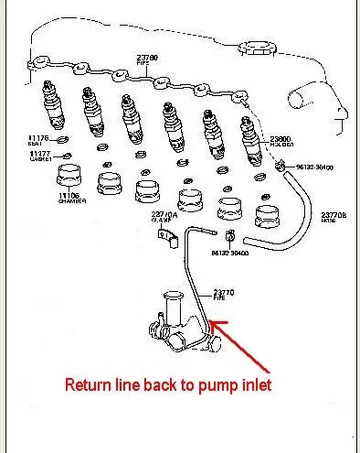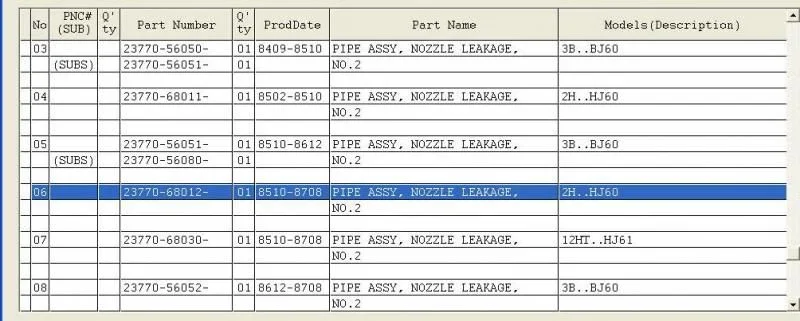OK. I will do that. Y
ou had some comments in this thread too, where you said that if one could start the car quite easily without bleeding it, then there's no air in the system, which seems to bolster my theory that it is indeed a strong vacuum that's starving my IP of fuel, rather than air blocking up the injectors.
In fact, the fact that I could drive 40 km to work this morning should give some clues right? Can someone drive that far with air in the system? Mind you, it was smooth all the way. Then open the cap at work, BIG whoosh.
The fuel cap that I have is a metal one, that looks like it came with the Cruiser. Its tethered by a chain to the body.
Hi Mark.
That statement I made (in that thread you've provided a link to) was based on my experience with my own BJ40 where the injector bleed line goes back into my fuel pump inlet. With this setup, cranking an engine alone (without providing an opening for the air to escape ... such as by "opening a bleed nipple" or "cracking a nut") can never purge out trapped air. So such an engine will not restart by cranking alone.
However the situation is different where the bleed line returns to the fuel tank. Here it may be possible to purge air by cranking alone.
(When the diesel vehicles at work run out of fuel the mechanics just add fuel to the tank and crank away for however long it takes for them to fire up. Under the same circumstances my BJ40 would NEVER fire up even if my battery and starter motor could last indefinitely.)
So back then (when I made that post) I think I probably thought all B-series and H-series engines were piped (fuel-wise) the same as mine.
I see the Toyota EPC does list different caps for diesel versus petrol fuel tanks.....Not sure what to conclude from that though.
Other causes for your problem could be muck in the tank (periodically blocking the fuel from exiting), fuel gelling (from cold weather or bacteria/microbes etc).
BTW - If there is no way for air to enter your tank to replace the fuel that fuel pump extracts - then I agree with you that your engine WILL inevitably shut down from lack of fuel. (Being a Landcruiser or Mercedes makes no difference here.).
And I'll go back now and reread this thread (and the one you've provided a link to) because I'm in dangerous territory by making this post without having studied it all properly.

(I'll edit it if I need to.)

Ist edit/additions after rereading this thread:
I totally agree with replacing your primer pump. (
Your old one leaks fuel They should NEVER leak fuel. And if you have a policy of "letting faults go unfixed simply because your cruiser (or mercedes) still runs OK" then I think you're on a slippery slope.
And I think the best way to see if your injector bleed line feeds back into your pump inlet (to recirculated trapped air) is to check/look in your engine bay. (I think "air entering your fuel line" could only be a possible cause if your return line goes all the way back to the tank. Because only then could your "restarting without purging" be explained".)
And I doubt anyone else here has to use both hands to remove their fuel cap ... which is key evidence for suggesting the "rag instead of cap" test. (But then again, less tank-vacuum will be beneficial if you have any sort of fuel-line-flow-restriction too. So if the rag makes the symptoms disappear, it still may not really be a "tank venting fault" ... and perhaps you have unusually weak hands LOL.)
And heck ... if you've never EVER changed your fuel filter DO IT IMMEDIATELY as that could be the cause in itself.
And BTW - My fuel cap has no obvious vent hole in it.
Now to re-read that linked thread.................
2nd edit:
Well ....I just reread that linked thread and I don't really have much to add here from doing so.
Except that I believe my BJ40 tank is vented through some weird system that I remember noticing during rust-treatment work a few years ago. If I remember correctly there's a bunch of tubes/pipes located behind a little cover that is accessed from outside the vehicle. It is in my RH-rear wheel-well just in front of that RH-rear wheel. So for all I know my fuel cap may have a "perfect seal" on my fuel filler neck (and yours could be the same).
And the "rag instead of cap test", if successful, doesn't necessarily prove the cap is faulty. It could mean that your "hidden venting system" is faulty or it could just mean you have a "fuel restriction fault" (and "less fuel tank vacuum" removes its symptoms).
I'm meandering a bit in this post I know.................... Can't help it I guess.













 )
)